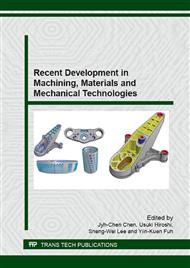p.479
p.484
p.490
p.496
p.500
p.509
p.515
p.520
p.526
Behavior of MnS on Belag Formation and Observation on Carbide Tool
Abstract:
In the 1960s, Opitz discovered the formation of complex oxide protective layers (Belag) on worn surfaces of tools when cutting Ca deoxidized steel. Belag formation is used in a free-cutting technique for steel and cast iron because it significantly reduces diffusional wear by preventing direct contact between the tool and work material; hence, tool life can be dramatically prolonged. For Belag to form, one condition is that the tool material should contain TiC. It has been reported that Belag adheres to tool surfaces because TiC in the tool oxidizes and reacts with Belag. Our study aims to clarify the formation and adhesion mechanisms of Belag. In this study, Ca deoxidized steel was machined with noncoated carbide P10 tools, and the state of the interface between the tool and Belag layer was investigated by transmission electron microscopy (TEM) and elemental analyses. As a result, we found that Belag directly adhered to Ti carbide (Ti–W–C) particles on tool surfaces. In contrast, Belag did not directly adhere to WC or Co on tool surfaces. Unlike previous studies, we could not confirm the formation of the TiC oxide or its oxide layer near the interface to which Belag adhered. In addition, when we machined a Ca deoxidized steel containing MnS, a CaS layer formed in Belag at the interface between the tool and Belag layer.
Info:
Periodical:
Pages:
500-505
Citation:
Online since:
July 2015
Keywords:
Price:
Сopyright:
© 2015 Trans Tech Publications Ltd. All Rights Reserved
Share:
Citation:


